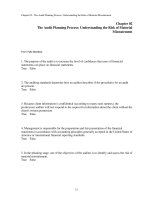Test bank for child and adolescent development an integrated approach 1st edition by bjorklund
Bạn đang xem bản rút gọn của tài liệu. Xem và tải ngay bản đầy đủ của tài liệu tại đây (89.42 KB, 16 trang )
Full file at />
Chapter 1: Introduction to Child and Adolescent Development
MULTIPLE CHOICE
1. Bidirectionality of structure and function refers to
a. an organism’s being capable of using either hand or foot.
b. genetic determinism.
c. the interaction of the functional invariants of assimilation and accommodation with
cognitive
schemas.
d. structure (e.g., biological substrate) affecting function (e.g., activity) and function
affecting
structure.
ANS: D
REF: 11
OBJ: Themes and Issues in Developmental Psychology
2. A hallmark of experimental studies is
a. the manipulation of time in the presentation of the materials to the subject.
b. the manipulation of only one variable as often as possible to determine the effects of that
variable.
c. the manipulation of every variable at each stage of the experiment.
d. the manipulation of one or more factors and observation of how these manipulations
change
the behavior under investigation.
ANS: D
REF: 32
OBJ: Research Methods in Child and Adolescent Development
KEY: WWW
3. If a researcher found, in a correlational study, that an increase in one factor resulted in an
increase of the same magnitude in another factor, the correlation, or r, would be
a. -1.0.
c. 0.5.
b. 0.0.
d. +1.0.
ANS: D
REF: 31
OBJ: Research Methods in Child and Adolescent
4. The ability to assess changes within an individual over time is a major benefit of the
____________ design.
a. longitudinal
c. correlational
b. experimental
d. clinical
ANS: A
REF: 34
OBJ: Research Methods in Child and Adolescent Development
5. A _____________ is a group of people born in a specified, limited span of years whose
common experiences might influence their performances in developmental research.
a. cohort
c. population
b. cross-section
d. sample
ANS: A
REF: 35
OBJ: Research Methods in Child and Adolescent Development
buy this full document at
Full file at />
6. Theorists who propose that people progress through discrete, developmental stages believe in
a. an intrinsically active child.
c. discontinuity of development.
b. an intrinsically passive child.
d. continuity of development.
ANS: C
REF: 14
OBJ: Themes and Issues in Developmental Psychology
7. Which of the following terms refers to development of the individual over the course of his or her
lifetime?
a. ontogeny
c. microgenesis
b. phylogeny
d. maturation
ANS: A
REF: 5
OBJ: Concepts in Developmental Psychology
8. Genetic determinism implies that
a. genetic variation is the basis for determinant thinking.
b. behavior is caused by the interaction of genes and environment.
c. culture determines all of behavior.
d. genes determine behavior.
ANS: D
REF: 17
9. In naturalistic observations, the researcher
a. interviews participants one-on-one.
b. intervenes as little as possible.
OBJ: Themes and Issues in Developmental Psychology
c. sets up a specific environment.
d. begins a case study.
ANS: B
REF: 26
OBJ: Research Methods in Child and Adolescent Development
10. The focus of developmental psychology is changes in
a.
b.
c.
d.
psychological characteristics that occur over a lifetime.
developmental theories.
data collection and analysis.
the way in which case studies are developed.
ANS: A
REF: 5
OBJ: Concepts in Developmental Psychology
11. Many developmental psychologists believe that childhood is a(n) _______ concept.
a. irrelevant
c. modern
b. outdated
d. complicated
ANS: C
REF: 7
OBJ: A Brief History of Childhood
12. Members of the Child Study Movement believed that developmental psychology should be applied to
children
a. throughout their lives.
c. in a theoretical way.
b. in a practical way.
d. in research studies.
ANS: B
REF: 10
OBJ: A Brief History of Childhood
13. Children are said to be in a stage when their behavior is _________ different from the behavior of
children in earlier or later stages.
buy this full document at
Full file at />
a. quantitively
b. qualitatively
c. quantifiably
d. correlationally
ANS: B
REF: 14
OBJ: Themes and Issues in Developmental Psychology
14. Researchers whose principal concern is with individual differences have a(n) ________ approach.
a. idiographic
c. simplistic
b. metamorphic
d. rationalistic
ANS: A
REF: 15
OBJ: Themes and Issues in Developmental Psychology
15. John Locke is the philosophical grandfather of
a. performationism.
c. determinism.
b. empiricism.
d. parsimony.
ANS: B
REF: 16
OBJ: Themes and Issues in Developmental Psychology
16. Which of the following is most useful for obtaining information that cannot ethically be obtained
otherwise?
a. questionnaires
c. case studies
b. observational studies
d. standardized tests
ANS: C
REF: 28
OBJ: Research Methods in Child and Adolescent Development
17. _________ is the emergence of new structures and functions during the course of
development.
a. Epigenisis
c. Mutation
b. Evolution
d. Adaptation
ANS: A
REF: 17
OBJ: Themes and Issues in Developmental Psychology
18. Some human behavior appears to be “instinctive” because humans inherit _____ as well as a speciestypical genome.
a. innate behaviors
c. a maternal attachment
b. gene expression
d. a species-typical environment
ANS: D
KEY: WW
REF: 19
OBJ: Themes and Issues in Developmental Psychology
19. A ________ is the time in development when a skill is most easily attained.
a. transitional period
b sensitive period
b. stage
c. function
ANS: B
REF: 20
OBJ: Themes and Issues in Developmental Psychology
20. ____ is to the extent to which a measurement accurately assesses what it purports to measure.
a. Validity
c. Parsimony
b. Reliability
d. Variability
ANS: A
REF: 22
OBJ: Research Methods in Child and Adolescent Development
buy this full document at
Full file at />
21. Which of the following involves assessing children over relatively short intervals, usually days or
weeks?
a. experimental studies
c. case studies
b. observational studies
d. microgenetic studies
ANS: D
REF: 36
OBJ: Research Methods in Child and Adolescent Development
22. Which of the following is not a major problem of conducting research with school-age children?
a. Researchers must comply with school schedules.
b. Researchers have difficulty formulating a research plan.
c. Researchers need approval from a number of different people.
d. Some children are unwilling to participate.
ANS: B
REF: 37
OBJ: Research Methods in Child and Adolescent Development
23. ________ includes changes in processes involved with thinking, such as perception, attention,
consciousness, memory, intelligence, problem solving, and language.
a. Physical development
c. Cognitive development
b. Psychomotor development
d. Socioemotional development
ANS: C
REF: 5
OBJ: Concepts in Developmental Psychology
24. During the Industrial Revolution in the U.S. and Europe, children
a. were killed as sacrifices.
b. worked long hours in factories.
c. were required to attend school.
d. were punished for crimes the same way as adults were.
ANS: B
REF: 7, 8
OBJ: Concepts in Developmental Psychology
25. Many developmental psychologists today collaborate with experts in various fields of
a. biology.
c. botany.
b. physics.
d. orthopedics.
ANS: A
REF: 10
OBJ: A Brief History of Developmental Psychology as a Science
26. If a characteristic is _____, a child’s rank in relation to his or her peers essentially stays the same over
time.
a. plastic
c. stable
b. erratic
d. innate
ANS: C
KEY: WW
REF: 12
27. A cause is endogenous if it is caused by
a. experience.
OBJ: Themes and Issues in Developmental Psychology
c. nurture.
buy this full document at
Full file at />
b. reinforcement.
ANS: D
d. nature.
REF: 12
OBJ: Themes and Issues in Developmental Psychology
28. Which of the following does a developmental psychologist not try to integrate in the study of child and
adolescent development?
a. infanticide
c. a sociocultural perspective
b. developmental contextualism
d. evolutionary theory
ANS: A
REF: 10
OBJ: A Brief History of Developmental Psychology as a Science
29. The modern concept of childhood is a(n) _____ invention.
a. Western
c. abstract
b. worldwide
d. African
ANS: A
REF: 9
OBJ: A Brief History of Childhood
30. When was the first U.S. federal law passed regulating the minimum age and number of hours per week
that children could work?
a. in the 1850s
c. in the 1930s
b. in the 1880s
d. in the 1960s
ANS: C
REF: 9
OBJ: A Brief History of Childhood
31. Development always occurs within a(n) ______ context.
a. social
c. objective
b. isolated
d. historical
ANS: A
REF: 11
OBJ: A Brief History of Developmental Psychology as a Science
32. Kagan’s belief that experience early in life is critical and nonreversible in the establishment of certain
aspects of social and intellectual behavior is called the ______ model of development.
a. genes–environment
c. tabula rasa
b. tape recorder
d. early childhood
ANS: A
REF: 12
OBJ: Themes and Issues in Developmental Psychology
33. The ability to change as a result of experience is called
a. discontinuity.
c. internal validity.
b. attachment.
d. plasticity.
ANS: D
REF: 12
OBJ: Themes and Issues in Developmental Psychology
34. One weakness of using _______ to collect data is that self-reporting can be biased.
a. questionnaires
c. structured interviews
b. observational studies
d. case studies
ANS: A
REF: 24
OBJ: Research Methods in Child and Adolescent Development
buy this full document at
Full file at />
35. Pellegrini and Long’s research into middle-school children’s “push and poke courtship” behavior is an
example of
a. structured observation.
c. contextual observation.
b. naturalistic observation.
d. standardized observation.
ANS: B
REF: 26-27
OBJ: Research Methods in Child and Adolescent Development
36. Why is it that some information about children can be ethically collected only by case studies?
a. It is not acceptable to question children about painful experiences.
b. Only psychiatrists are licensed to conduct case studies.
c. Case studies often document extreme conditions that would be cruel to set up.
d. Case studies often involve punishment for children who are unwilling to participate.
ANS: C
REF: 28
OBJ: Research Methods in Child and Adolescent Development
37. The term ______ in psychology refers to the empirical study of a topic.
a. research
c. experiment
b. observation
d. variable
ANS: A
REF: 31
OBJ: Research Methods in Child and Adolescent Development
38. Truly scientific experiments require that participants be ______ assigned to the different experimental
conditions.
a. selectively
c. temporarily
b. sequentially
d. randomly
ANS: D
REF: 33
OBJ: Research Methods in Child and Adolescent Development
KEY: WW
39. Which of the following would not be an example of a group case study?
a. children who survived a hurricane in a specific area
b. children who took a standardized test in a classroom
c. children who were raised in an orphanage
d. children who were sexually abused
ANS: B
REF: 33
OBJ: Research Methods in Child and Adolescent Development
40. The greatest weakness of a cross-sectional study is
a. that it requires much time and is expensive.
b. that there is significant participant loss.
c. that it cannot assess change in one person over time.
d. that it does not focus on a single topic of development.
ANS: C
REF: 34
OBJ: Research Methods in Child and Adolescent Development
41. If it is true that boys are less likely than girls to have their parents sign permission slips, this could
create the problem of ______ a psychological study.
a. obtaining a representative sample for
b. obtaining permission to conduct
buy this full document at
Full file at />
c. the ethics of conducting
d. children’s compliance with the guidelines of
ANS: A
REF: 37
OBJ: Research Methods in Child and Adolescent Development
42. For which of the following would the microgenetic method be most useful?
a. observing children in their natural environment
b. correcting behavioral problems
c. describing changes over a long period of time
d. assessing spelling strategies
ANS: D
REF: 36
OBJ: Research Methods in Child and Adolescent Development
43. One ethical consideration that is necessary in conducting research with children is
a. making sure that incentives are generous.
b. informing children about aspects of the research.
c. including the names of all children in written research records.
d. informing children’s parents about the results of the research.
ANS: B
REF: 38
OBJ: Research Methods in Child and Adolescent Development
44. What is the best way to obtain children as participants for research?
a. advertising in local newspapers
b. contacting relatives and friends who have children
c. contacting local schools
d. circulating flyers in different neighborhoods
ANS: C
REF: 37
OBJ: Research Methods in Child and Adolescent Development
45. Because it is rooted biology, development is _______, but because of individual differences,
development is also ________.
a. predictable; variable
c. stable; plastic
b. variable; predictable
d. plastic; stable
ANS: A
REF: 5
OBJ: Concepts in Developmental Psychology
46. What was outlawed in Europe in the 1600s?
a. child labor
b. child prostitution
ANS: C
REF: 6
c. child abandonment
d. orphanages
OBJ: A Brief History of Childhood
47. Why do some researchers believe that contemporary childhood has moved backward?
a. because children today are often spoiled by their parents
b. because children today are under too much pressure to succeed
c. because children spend so much time being unsupervised
d. because TV has made children privy to adult issues
buy this full document at
Full file at />
ANS: D
REF: 8
OBJ: A Brief History of Childhood
48. All 192 countries that are members of the United Nations ratified The Convention on the Rights of the
Child in 1989 except Somalia and __________
a. the United States.
c. Brazil.
b. France.
d. China.
ANS: A
REF: 9
OBJ: A Brief History of Childhood
49. After World War I, European psychologists such as Piaget, Vygotsky, Wallon, and Werner placed the
most emphasis for child development on
a. applying it in practical ways.
b. explaining it in theoretical ways.
b. developing case studies.
c. genetic influences.
ANS: B
REF: 10
OBJ: A Brief History of Developmental Psychology as a Science
50. The nature/nurture issue is essentially the interaction of
a. genetics and heredity.
c. culture and family.
b. society and the individual.
d. biology and experience.
ANS: D
KEY: WW
REF: 16
OBJ: Themes and Issues in Developmental Psychology
51. A _______ best represents qualitatively different stages in the life of a single animal.
a. monkey
c. human
b. butterfly
d. snake
ANS: B
REF: 14
OBJ: Themes and Issues in Developmental Psychology
52. The concept that change from one style of behaving or thinking to another is relatively abrupt is called
a. discontinuity of development.
c. disruption of development.
b. continuity of development.
d. evolution of development.
ANS: A
KEY: WWW
REF: 14
OBJ: Themes and Issues in Developmental Psychology
53. ____ is often viewed as the major cause of individual differences in patterns of development.
a. Personality
c. Culture
b. Prenatal development
d. Family structure
ANS: C
REF: 16
OBJ: Themes and Issues in Developmental Psychology
54. Most developmental psychologists today are
a. nativists.
b. genetic determinists.
ANS: C
REF: 17
c. interactionists.
d. creationists.
OBJ: Themes and Issues in Developmental Psychology
55. Gottlieb’s research showed that ducklings respond to their mothers’ calls because of _________
a. heredity
c. mimicry
b. instinct
d. auditory experience
buy this full document at
Full file at />
ANS: D
REF: 18
OBJ: Themes and Issues in Developmental Psychology
56. What explains why infants and children more easily make sense of faces and sounds than other things,
such as lists of words?
a. Infants and children learn the easiest things first, and then progress to harder tasks.
b. Specific parts of the brain are limited to processing a narrow range of information.
c. The brain and learning mechanisms can perform many tasks at once.
d. There are no constraints on learning to make sense of faces and language.
ANS: B
REF: 19
OBJ: Themes and Issues in Developmental Psychology
57. The results of even the most interesting study might be of little use, depending on
a. how the results are interpreted.
b. whether or not the scientific community agrees with the results.
c. how the study was conducted.
d. what the independent variable were.
ANS: C
REF: 21
OBJ: Research Methods in Child and Adolescent Development
58. Which of the following is the correct historical order of the different levels of analysis of
developmental phenomena?
a. sociohistory ? phylogeny ? ontogeny
c. ontogeny ? phylogeny ? sociohistory
b. phylogeny ? sociohistory ?ontogeny
d. ontogeny ? sociohistory ? phylogeny
ANS: B
REF: 11
OBJ: A Brief History of Developmental Psychology as a Science
59. ______ is the extent to which a test or measurement represents all facets of a given concept.
a. Internal validity
b. External validity
c. Face validity
d. Content validity
ANS: D
REF: 23
OBJ: Research Methods in Child and Adolescent Development
60. Which of the following is most useful for generating hypothesis for future experimental testing?
a. clinical interviews
c. observational studies
b. questionnaires
d. structured interviews
ANS: A
REF: 28
OBJ: Research Methods in Child and Adolescent Development
61. In a study of aggression in preschool children, each of three groups regularly saw one of three types of
TV shows: aggressive programs (such as “Batman”), prosocial programs (“Mister Rogers’
Neighborhood”), and neutral programs (such as Disney nature films). Aggressive behavior was then
assessed. What was the dependent variable?
a. the type of TV show
c. the number of groups of children
buy this full document at
Full file at />
b. the children’s level of aggression
d. the age of the children
ANS: B
REF: 32-33
OBJ: Research Methods in Child and Adolescent Development
KEY: WW
62. Humans emerged as a species about _________ years ago.
a. 2 billion
c. 2 million
b. 20 million
d. 200,000
ANS: C
REF: 11
OBJ: Research Methods in Child and Adolescent Development
63. In a study of the development of social skills, a group of children were tested every other year for 6
years. This was a _______ study.
a. cross-sectional study
c. longitudinal study
b. horizontal study
d. case study
ANS: C
REF: 34
OBJ: Research Methods in Child and Adolescent Development
64. Modern developmental psychologists realize that development is more _____ than was once believed.
a. stable
c. instinctual
b. plastic
d. complicated
ANS: B
REF: 13
OBJ: Themes and Issues in Developmental Psychology
65. Teenagers who have been raised in severely disadvantaged homes yet have no serious problems have
the characteristic of
a. competency.
c. sociability.
b. intelligence.
d. resiliency.
ANS: D
REF: 13
OBJ: Themes and Issues in Developmental Psychology
66. Which of the following is an example of a stage in human development?
a. learning to speak
b. childhood
b. adulthood
c. puberty
ANS: C
REF: 14
OBJ: Themes and Issues in Developmental Psychology
67. After about 8 months, infants exhibit ______, understanding that even when an object is out of their
sight, it still exists.
a. object attachment
c. logic
b. object permanence
d. discontinuity
ANS: B
REF: 14
OBJ: Themes and Issues in Developmental Psychology
68. Psychologists who adopt an idiographic approach are most interested in
buy this full document at
Full file at />
a. behavior that is typical.
b. behavior that is extreme.
c. behavior that is individual.
d. behavior that is new.
ANS: C
REF: 39
OBJ: Research Methods in Child and Adolescent Development
69. Which of the following is most easily acquired during a sensitive time in development?
a. learning a new sport
b. learning a language
c. learning new methods of mathematical calculations
d. learning concepts of mechanics
ANS: B
REF: 20
OBJ: Themes and Issues in Developmental Psychology
70. Which of the following must be included for a scientific observation to be objective?
a. the observer’s personal beliefs
b. the observer’s emotions
c. the observers prior expectations
d. the observer’s skill at knowing what is clearly observable
ANS: D
REF: 21
OBJ: Research Methods in Child and Adolescent Development
71. The time boundaries for a critical period are ______ than they are for a sensitive period.
a. closer together
c. wider
b. farther apart
d. narrower
ANS: D
KEY: WW
REF: 20
OBJ: Themes and Issues in Developmental Psychology
72. Which of the following is not likely to be included on a questionnaire designed to collect data about
children’s behavior?
a. peer nominations
c. self-reporting
b. a measure of IQ
d. descriptions of behaviors
ANS: B
REF: 25-26
OBJ: Research Methods in Child and Adolescent Development
73. Non-stage theorists believe that development changes qualitatively and
a. gradually over time.
c. in unpredictable ways.
b. in distinct stages.
d. quantitatively.
ANS: A
REF: 14-15
OBJ: Themes and Issues in Developmental Psychology
74. Watching what toddlers do in a daycare center when they are on their own is an example of
a. a case study.
c. an observational study.
b. a cross-sectional study.
d. a clinical study.
ANS: C
REF: 26
buy this full document at
Full file at />
OBJ: Research Methods in Child and Adolescent Development
75. ____ is the extent to which a measure relates to a theorized psychological concept, such as intelligence
or personality.
a. Face validity
b. Internal validity
c. Content validity
d. Construct validity
ANS: D
REF: 23
OBJ: Research Methods in Child and Adolescent Development
76. Which of the following is not a problem in conducting research with children?
a. getting children to understand the nature of the research
b. obtaining children to serve as participants
c. subject loss
d. obtaining representative samples
ANS: A
REF: 36-37
OBJ: Research Methods in Child and Adolescent Development
77. Socioemotional development includes all of the following except
a. self-esteem.
c. intelligence.
b. personality.
d. morality
ANS: C
REF: 5
OBJ: Concepts in Developmental Psychology
78. One-fourth of infants born in Paris in the 1700s
a. died.
c. participated in developmental studies.
b. became foundlings.
d. were sold as slaves.
ANS: B
REF: 6-7
OBJ: A Brief History of Childhood
79. Who was an ardent advocate of childhood, believing that children are important in their own right and
are not merely a means to the end of being adults?
a. Piaget
c. Freud
b. Vygotsky
d. Rousseau
ANS: D
REF: 7
OBJ: A Brief History of Childhood
80. What is the significance of the United Nations’ approval of The Convention on the Rights of the
Child?
a. It acknowledges the special nature of childhood.
b. It enforces protection of children worldwide.
c. It coordinates how children are treated worldwide.
d. It creates a new definition of “childhood.”
ANS: A
REF: 9
OBJ: A Brief History of Childhood
81. The _______ of psychology recognizes the centrality of the social environment for human
development.
a. developmental contextualism
c. sociocultural perspective
b. evolutionary theory
d. developmental systems theory
buy this full document at
Full file at />
ANS: C
REF: 11
OBJ: A Brief History of Developmental Psychology as a Science
82. According to Schaffer, the answer to the question of whether or not extreme childhood trauma causes
irreversible damage is
a. “Yes.”
c. “There is no way to know.”
b. “No.”
d. “It depends.”
ANS: D
REF: 13
OBJ: Themes and Issues in Developmental Psychology
83. Which of the following is not a bidirectional influence on development?
a. prenatal care
c. environment
b. behavior
d. neural activity
ANS: A
REF: 18
OBJ: Themes and Issues in Developmental Psychology
84. What is the most important aspect of a study that has external validity?
a. It allows researchers to make cause-effect statements abut the variables studied.
b. It can be generalized to other people who were not involved in the study.
c. It reflects what it is supposed to measure.
d. It measures all concepts of a given aspect.
ANS: B
REF: 22
OBJ: Research Methods in Child and Adolescent Development
85. Regarding ethics in psychological studies, the consideration of jeopardy is important because it
a. provides guidelines that make sure that children will not be harmed.
b. ensures that any assistance necessary for the child as a result of such studies will be
provided.
c. ensures that children understand what will be involved in the course of such studies.
d. provides assurance to parents that information related to such studies will be confidential.
ANS: B
REF: 38
OBJ: Research Methods in Child and Adolescent Development
86. Children’s social, intellectual, and physical skills develop mainly as a result of
a. chronological age.
b. encouragement of parents and other family members.
c. interactions between physical changes in the child and his or her environment.
d. interactions between the child and his or her peers.
ANS: C
KEY: WWW
REF: 6
OBJ: Concepts in Developmental Psychology
87. Is it possible for any two individuals on Earth to have the same set of genes?
a. no
c. yes, brothers and sisters do
b. yes, parents and their children do
d. yes, identical twins do
ANS: D
REF: 15-16
OBJ: Themes and Issues in Developmental Psychology
88. Which term is essentially antithetical to a bidirectional perspective?
buy this full document at
Full file at />
a. genetic determinism
b. nativism
ANS: A
c. socialism
d. universalism
REF: 19
OBJ: Themes and Issues in Developmental Psychology
89. What brought the study of child development into the academic mainstream and made developmental
psychology a first-level discipline within university psychology programs in the mid-19 th century?
a. the practical application of developmental research
b. the increasing scientific rigor practiced in developmental research
c. advances in communication between U.S. and European researchers
d. the collaboration of psychologists with scientists in other fields of study
ANS: B
REF: 10
OBJ: A Brief History of Developmental Psychology as a Science
KEY: WW
90. Middle childhood is generally considered to be the ages from
a. 2 to 7.
c. 7 to 12.
b. 4 to 10.
d. 12 to 16.
ANS: C
REF: 5
OBJ: Concepts in Developmental Psychology
91. Most modern American parents are likely to view their children as being
a. competent.
c. in need of protection.
b. innocent.
d. dependent.
ANS: A
REF: 8
OBJ: A Brief History of Childhood
92. ____ are examples of areas of physical and psychomotor development.
a. Memory and problem solving
c. Sensory systems
b. Self-esteem and love
d. temperament and personality
ANS: C
REF: 5
OBJ: Concepts in Developmental Psychology
93. Developmental psychologists who take the normative approach are most interest in studying
a. discontinuous development.
c. individual differences.
b. developmental function.
d. unusual behavior.
ANS: B
REF: 15
OBJ: Themes and Issues in Developmental Psychology
94. Which of the following is an aspect of nature, not nurture?
a. culture
c. experience
b. learning
d. biology
ANS: D
REF: 16
OBJ: Themes and Issues in Developmental Psychology
95. The behavior of ducklings that follow the first moving thing or animal that they see and stay with that
thing or animal after hatching is called
a. determinism.
c. imprinting.
b. nativism.
d. a cohort effect.
ANS: C
REF: 18
OBJ: Themes and Issues in Developmental Psychology
96. In _________ studies, the assignment of participants to groups cannot be made randomly.
a. correlational studies
c. experimental studies
buy this full document at
Full file at />
b. quasi-experimental studies
d. clinical studies
ANS: B
REF: 33
OBJ: Research Methods in Child and Adolescent Development
97. Which of the following is a combination of a cross-sectional approach and a longitudinal approach?
a. a cross-sequential approach
c. a normative approach
b. a microgenetic approach
d. an ideograhic approach
ANS: B
REF: 35
OBJ: Research Methods in Child and Adolescent Development
TRUE/FALSE
1. Human experiences begin at birth.
ANS: F
REF: 20
2. Reliability is the extent to which a measurement accurately assesses what it purports to.
ANS: F
REF: 23
3. Subject loss is a problem in conducting research with children.
ANS: T
REF: 37
4. One drawback to the cross-sectional approach is its inability to evaluate cohort effects.
ANS: F
REF: 35
5. It is ethical to offer incentives for participants in research.
ANS: T
REF: 38
6. John Locke’s view that children’s minds are like blank slates is widely accepted today.
ANS: F
REF: 7
7. Developmental psychologists often collaborate with geneticists and neuroscientists.
ANS: T
REF: 10
8. Development of psychological processes over an individual’s lifetime.
ANS: T
REF: 5
9. Stability refers to the ability to change as a result of experience.
buy this full document at
Full file at />
ANS: F
REF: 12
10. Stage theorists believe that changes from one stage to another, reflect discontinuity of development.
ANS: T
REF: 14
ESSAY
1. Analyze the ongoing debate about nature versus nurture. Explain whether or not you think this debate
can ever be resolved and whether or not it needs to be resolved.
ANS: Answer not provided
2. Describe the use of observational studies as a research method. In what types of situations would you
choose observational studies over structured interviews? Explain why.
ANS: Answer not provided
3. Identify the strengths and weaknesses of cross-sectional, longitudinal, and cross-sequential research
designs.
ANS: Answer not provided
4. Explain how an experimental study of child development is designed. Provide an example of an
experimental study that you might conduct, and identify the factors involved in your study.
ANS: Answer not provided
5. Describe each of the three major areas that are the focus of the study of child development.
ANS: Answer not provided
buy this full document at









